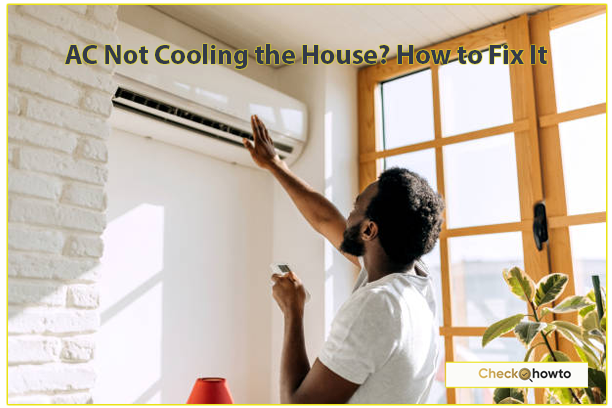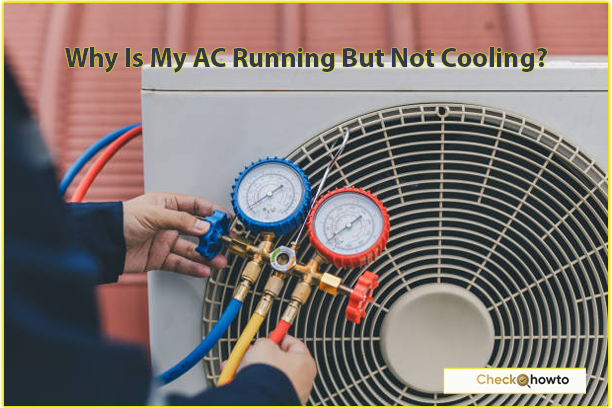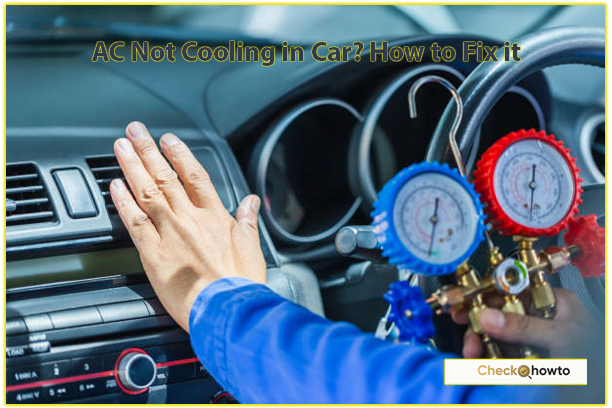When the summer heat is at its peak, there’s nothing more frustrating than realizing your air conditioner isn’t cooling your house properly. I’ve been there, and I know how uncomfortable and stressful it can be. If you’re reading this, chances are you’re facing the same issue, and you’re looking for solutions. Don’t worry I’m here to guide you through the process of diagnosing and fixing your AC problems.
Whether it’s a simple fix or something more complex, I’ll walk you through everything step by step. By the end of this article, you’ll have a clear understanding of why your AC isn’t cooling and how to resolve it.

Related; AC Not Cooling in Car? How to Fix it
Why Is My AC Not Cooling the House?
Before diving into fixes, it’s important to understand why your AC might not be cooling your home. I’ve found that the reasons can range from minor issues like a dirty air filter to more serious problems like a refrigerant leak or a malfunctioning compressor. Let’s explore the most common causes:
1. Dirty Air Filter
One of the first things I check when my AC isn’t cooling is the air filter. A clogged or dirty air filter restricts airflow, making it harder for your AC to cool your home. If you haven’t changed your filter in a while, this could be the culprit.
2. Thermostat Issues
Sometimes, the problem isn’t with the AC unit itself but with the thermostat. If your thermostat isn’t set correctly or is malfunctioning, it can prevent your AC from cooling properly.
3. Low Refrigerant Levels
Refrigerant is the lifeblood of your AC system. If there’s a leak or the refrigerant levels are low, your AC won’t be able to cool your home effectively. This is a more serious issue that often requires professional help.
4. Dirty Condenser Coils
The condenser coils, located in the outdoor unit, release heat from your home. If they’re covered in dirt or debris, they can’t do their job efficiently, leading to poor cooling performance.
5. Frozen Evaporator Coils
If your AC is running but not cooling, frozen evaporator coils could be the reason. This often happens due to restricted airflow or low refrigerant levels.
6. Blocked or Leaky Ducts
Leaky or blocked ductwork can prevent cool air from reaching your rooms. I’ve seen cases where ducts were so clogged that barely any air made it through.
7. Faulty Compressor
The compressor is the heart of your AC system. If it’s not working, your AC won’t cool your home. This is a complex issue that usually requires professional repair.
8. Oversized or Undersized AC Unit
If your AC unit is too large or too small for your home, it won’t cool efficiently. An oversized unit will cycle on and off too frequently, while an undersized unit will struggle to cool your space.
Step-by-Step Guide to Fixing Your AC
Now that we’ve identified the common causes, let’s dive into the solutions. I’ll walk you through each step, starting with the simplest fixes and moving on to more complex ones.
1. Check and Replace the Air Filter
The first thing I always do is check the air filter. Here’s how you can do it:
- Locate your air filter. It’s usually found in the return air duct or near the air handler.
- Remove the filter and hold it up to the light. If you can’t see light passing through, it’s time to replace it.
- Replace the filter with a new one of the same size and type.
Replacing a dirty air filter can significantly improve airflow and cooling efficiency. I recommend checking your filter every month and replacing it every 1-3 months, depending on usage.
2. Inspect the Thermostat
Next, I check the thermostat settings. Here’s what you should do:
- Ensure the thermostat is set to “cool” mode.
- Set the temperature lower than the current room temperature to see if the AC kicks on.
- If your thermostat uses batteries, replace them to rule out a power issue.
If your thermostat is outdated or malfunctioning, consider upgrading to a programmable or smart thermostat for better control and energy efficiency.
3. Clean the Condenser Coils
Dirty condenser coils can hinder your AC’s performance. Here’s how I clean them:
- Turn off the power to the outdoor unit.
- Remove any debris, such as leaves or grass, from around the unit.
- Use a garden hose to gently spray the coils and remove dirt. Avoid using a pressure washer, as it can damage the fins.
Cleaning the condenser coils can improve heat transfer and help your AC cool more effectively.
4. Check for Frozen Evaporator Coils
If your AC is running but not cooling, frozen evaporator coils could be the issue. Here’s what I do:
- Turn off the AC and let the coils thaw completely.
- Check for restricted airflow, such as a dirty air filter or blocked vents.
- If the problem persists, call a professional to check for low refrigerant levels.
5. Inspect the Ductwork
Leaky or blocked ducts can prevent cool air from reaching your rooms. Here’s how I inspect them:
- Check for visible leaks or disconnected ducts in accessible areas, such as the attic or basement.
- Seal any leaks with duct tape or mastic sealant.
- Ensure all vents are open and unobstructed.
If you suspect major ductwork issues, consider hiring a professional to inspect and repair them.
6. Check Refrigerant Levels
Low refrigerant levels can prevent your AC from cooling properly. Here’s what I recommend:
- Look for signs of a refrigerant leak, such as hissing sounds or ice buildup on the refrigerant lines.
- If you suspect a leak, call a licensed HVAC technician to locate and repair it.
Refrigerant handling requires specialized equipment and training, so this isn’t a DIY job.
7. Test the Compressor
The compressor is a critical component of your AC system. Here’s how I test it:
- Listen for unusual noises, such as clicking or humming, when the AC is running.
- If the compressor isn’t turning on, it could be due to electrical issues or a faulty capacitor.
- Call a professional to diagnose and repair compressor problems.
8. Evaluate Your AC’s Size
If your AC unit is too large or too small for your home, it won’t cool efficiently. Here’s what I suggest:
- Consult an HVAC professional to determine the correct size for your home.
- Consider replacing an oversized or undersized unit with a properly sized one.
When to Call a Professional
While many AC issues can be resolved with DIY fixes, some problems require professional expertise. Here’s when I recommend calling an HVAC technician:
- You suspect a refrigerant leak.
- The compressor isn’t working.
- The AC still isn’t cooling after trying the above fixes.
- You’re unsure about performing any repairs yourself.
A licensed technician can diagnose and repair complex issues safely and efficiently.
Preventive Maintenance Tips
To avoid future AC problems, I follow these preventive maintenance tips:
- Change the air filter regularly.
- Schedule annual AC maintenance with a professional.
- Keep the outdoor unit clean and free of debris.
- Seal and insulate your ductwork.
- Upgrade to a programmable or smart thermostat.
Regular maintenance can extend the life of your AC and keep it running efficiently.
See; Why Is My AC Running But Not Cooling?
Conclusion
Dealing with an AC that’s not cooling your house can be frustrating, but with the right knowledge, you can often resolve the issue yourself. I’ve walked you through the most common causes and solutions, from checking the air filter to inspecting the compressor. Remember, regular maintenance is key to preventing problems and ensuring your AC runs smoothly all summer long.
If you’ve tried everything and your AC still isn’t cooling, don’t hesitate to call a professional. Your comfort is worth it!



